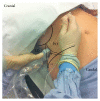Ultrasound-Guided Quadratus Lumborum Block: An Updated Review of Anatomy and Techniques
- PMID: 28154824
- PMCID: PMC5244003
- DOI: 10.1155/2017/2752876
Ultrasound-Guided Quadratus Lumborum Block: An Updated Review of Anatomy and Techniques
Abstract
Purpose of Review. Since the original publication on the quadratus lumborum (QL) block, the technique has evolved significantly during the last decade. This review highlights recent advances in various approaches for administering the QL block and proposes directions for future research. Recent Findings. The QL block findings continue to become clearer. We now understand that the QL block has several approach methods (anterior, lateral, posterior, and intramuscular) and the spread of local anesthetic varies with each approach. In particular, dye injected using the anterior QL block approach spread to the L1, L2, and L3 nerve roots and within psoas major and QL muscles. Summary. The QL block is an effective analgesic tool for abdominal surgery. However, the best approach is yet to be determined. Therefore, the anesthetic spread of the several QL blocks must be made clear.
Conflict of interest statement
The authors declare that there is no conflict of interests.
Figures










References
-
- Blanco R. TAP block under ultrasound guidance: the description of a ‘non pops technique’. Regional Anesthesia and Pain Medicine. 2007;32(supplement 1):p. 130. - PubMed
Publication types
MeSH terms
Substances
LinkOut - more resources
Full Text Sources
Other Literature Sources
Medical

